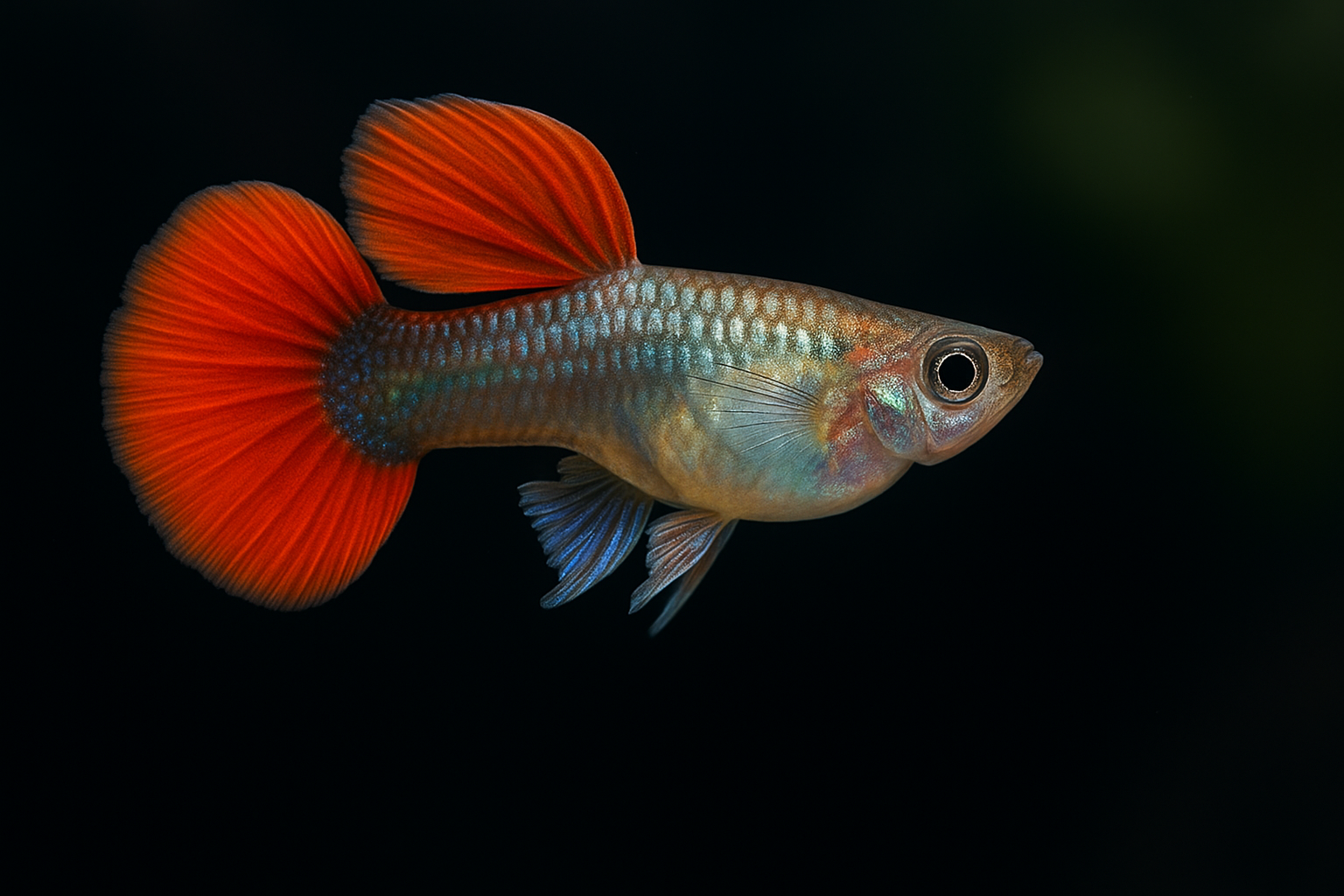The Round Tail Guppy is a delightful variant of the popular guppy fish, known for its uniquely shaped tail that resembles a semicircle or a fan. While guppies are famed for their vibrant colors and variety of tail shapes, the round tail guppy stands out due to its elegance and understated beauty. It’s an ideal choice for aquarists looking for diversity in their tank without the extravagance of more flamboyant strains.
This article provides a comprehensive guide to the Round Tail Guppy, covering everything from its origins, care, breeding, ideal tank conditions, and compatibility with other species. Whether you’re a beginner or a seasoned aquarist, this guide will help you understand why the Round Tail Guppy is a fantastic addition to your aquatic world.
1. Origins and History
The guppy (Poecilia reticulata) is native to South America, particularly in countries like Brazil, Trinidad, and Venezuela. Over time, guppies have been selectively bred into various strains featuring different colors, patterns, and tail shapes.
The Round Tail Guppy is one such breed that was developed through selective breeding, aiming to retain the natural guppy shape while introducing elegance and balance in its tail design. Unlike delta or fan tails, which can be more prone to damage, the round tail is resilient and easy to maintain, making it ideal for community aquariums.
2. Appearance of the Round Tail Guppy
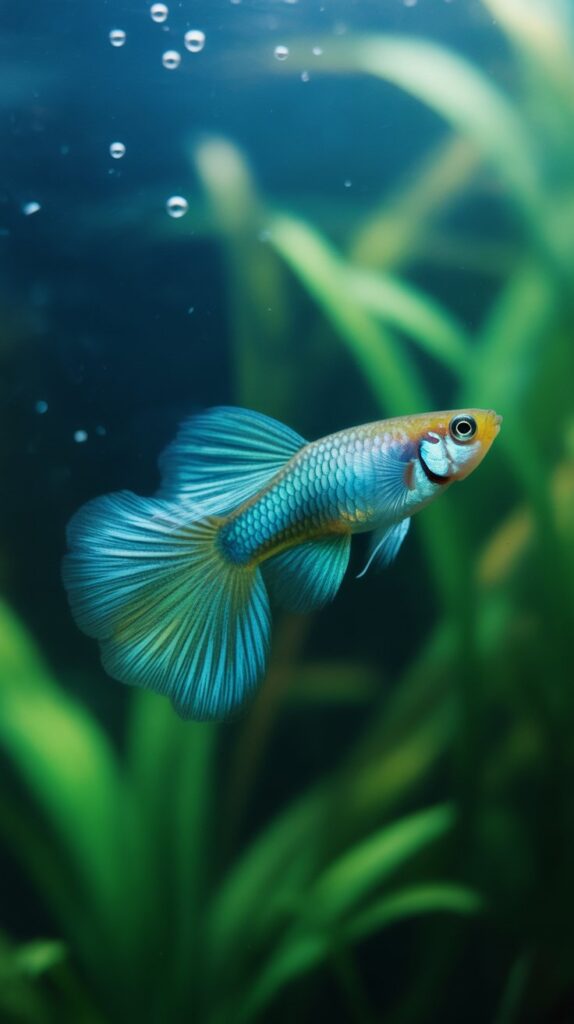
Round Tail Guppies exhibit a semicircular or fan-shaped tail that is smooth and symmetrical. This tail type is more compact than delta or lyretail guppies but still has a captivating flow when the fish swims.
Key Features:
- Tail Shape: Rounded, forming an arc or semicircle.
- Color Variations: Found in various colors such as red, blue, yellow, green, and multicolored strains.
- Size: Males typically grow up to 1.5 inches, while females can reach 2.5 inches.
- Body Shape: Slender males, fuller-bodied females.
- Fin Texture: Smooth and firm, with less susceptibility to tearing.
Their vibrant coloration combined with the graceful tail movement makes them a subtle yet beautiful presence in aquariums.
3. Habitat and Tank Requirements
Round Tail Guppies are hardy and adaptable, making them suitable for a wide range of tank conditions. However, providing the optimal environment ensures they live longer, stay healthier, and display better coloration.
Tank Setup:
- Tank Size: Minimum 10 gallons for a small group.
- Temperature: 72°F to 82°F (22°C – 28°C)
- pH Range: 6.8 – 7.8
- Water Hardness: 8 – 12 dGH
- Filtration: Gentle filtration system; avoid strong currents.
- Plants: Floating and rooted plants like guppy grass, java fern, and hornwort provide hiding spots and reduce stress.
- Lighting: Moderate lighting to enhance their coloration and promote plant growth.
Tank Mates:
Round Tail Guppies are peaceful and do well with other non-aggressive species like:
- Corydoras
- Tetras
- Platies
- Mollies
- Cherry shrimp
Avoid pairing them with fin-nippers like barbs or aggressive bettas.
4. Feeding and Diet
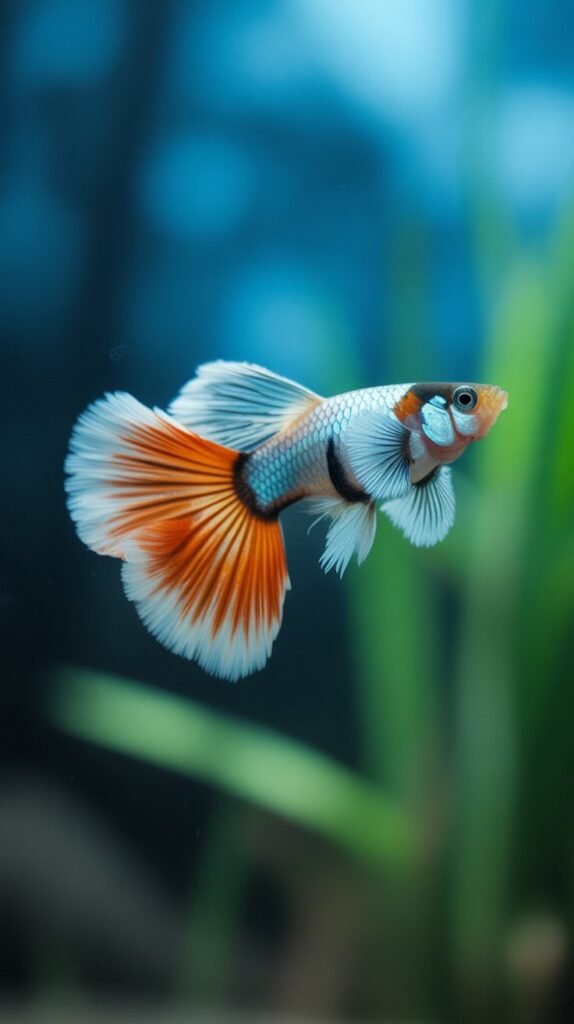
A balanced diet plays a significant role in the color vibrancy, activity level, and breeding success of your Round Tail Guppies.
Best Food Options:
- Flake Food: High-quality tropical fish flakes.
- Live/Frozen Foods: Daphnia, brine shrimp, bloodworms.
- Vegetables: Blanched spinach, peas.
- Pellets and Microgranules: For added nutrition.
Feed them 2–3 times a day in small portions they can consume within 2 minutes. Overfeeding can lead to water quality issues and obesity.
5. Behavior and Temperament
Round Tail Guppies are active, curious, and friendly, making them a favorite among community tank enthusiasts. Males are more colorful and tend to display courting behavior, while females are more subdued in coloration.
Behavior Traits:
- Schooling Nature: Prefer being in groups of 5 or more.
- Social Interactions: Peaceful with other tank mates.
- Playfulness: Often seen exploring plants, chasing one another, or interacting during feeding.
Due to their peaceful nature, they thrive in harmonious tanks with species that won’t outcompete them for food or harass them.
6. Breeding Round Tail Guppies
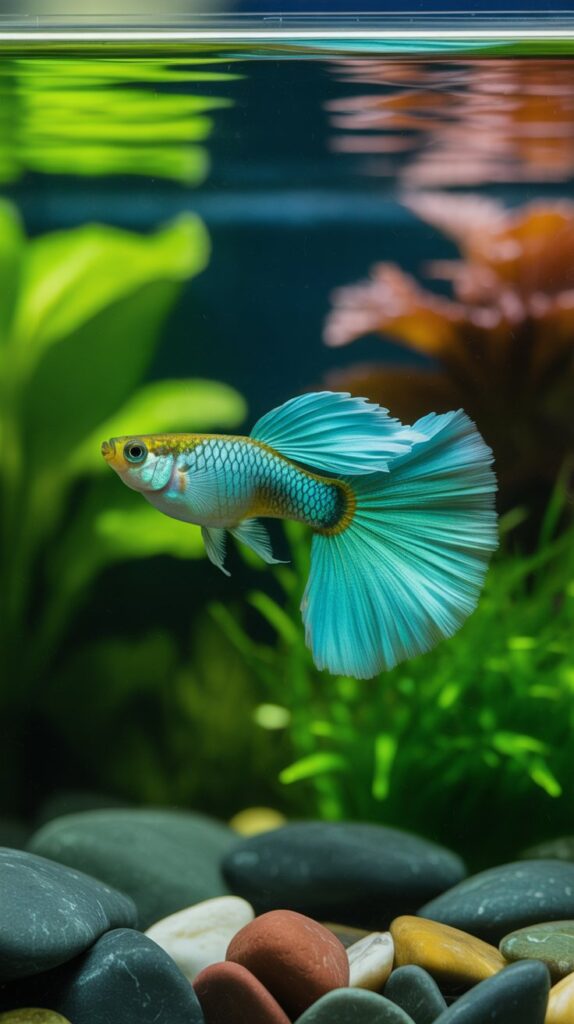
One of the highlights of owning guppies is their ease of breeding. Round Tail Guppies, like other guppies, are livebearers, meaning they give birth to live fry rather than laying eggs.
Breeding Guide:
- Sex Ratio: Keep 1 male for every 2–3 females to reduce stress.
- Gestation Period: 21–30 days.
- Signs of Pregnancy: Darkening gravid spot, swollen abdomen.
- Birthing Setup: Use a breeder box or a separate tank to protect fry from being eaten.
Fry Care:
- Feeding: Crushed flakes, baby brine shrimp, infusoria.
- Water Conditions: Keep temperature stable at 78–80°F.
- Survival Rate: Increase with hiding spots like moss and dense plants.
Selective breeding allows hobbyists to develop specific colors and patterns in Round Tail Guppies, making it a fun and rewarding hobby.
7. Common Health Issues
Despite being hardy, Round Tail Guppies can fall victim to common freshwater diseases, especially in poor tank conditions.
Common Diseases:
- Ich (White Spot Disease): Small white spots on the body and fins.
- Fin Rot: Decaying of the tail and fins, often due to dirty water.
- Velvet Disease: Gold dust-like film on skin and gills.
- Swim Bladder Issues: Difficulty in swimming, often caused by overfeeding or constipation.
Prevention Tips:
- Regular water changes (25–30% weekly).
- Avoid overfeeding.
- Quarantine new fish for 2 weeks.
- Maintain water parameters consistently.
Using a water conditioner and testing kits will help maintain optimal conditions.
8. Advantages of Keeping Round Tail Guppies
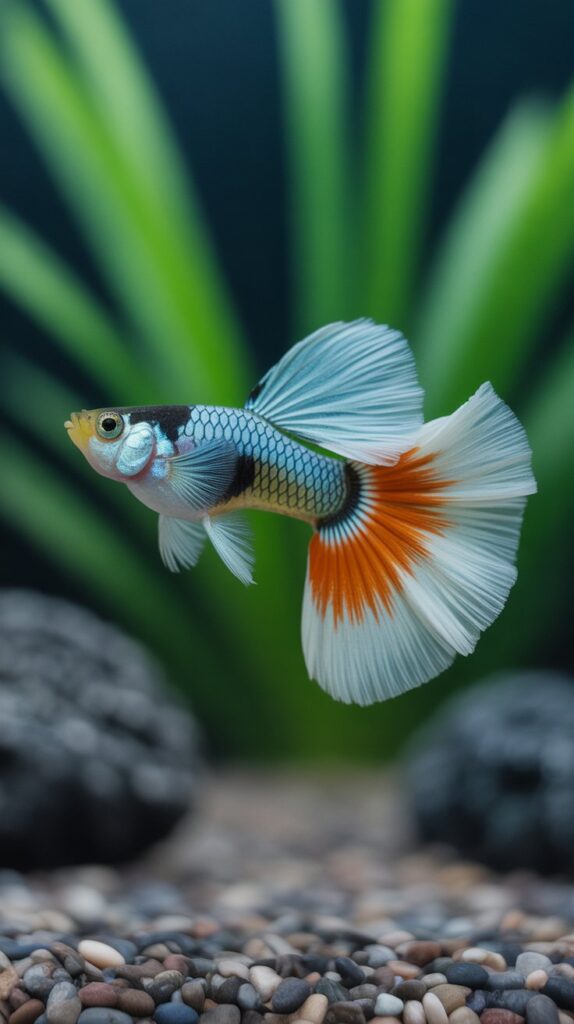
- Beginner-Friendly: Great for new aquarists due to their hardy nature.
- Aesthetically Pleasing: Subtle elegance without being overwhelming.
- Peaceful Community Member: Gets along well with many other species.
- Easy to Breed: Good for those interested in breeding projects.
- Low Maintenance: Adaptable to various environments.
9. Round Tail Guppies in Aquascaping
In aquascaped tanks, Round Tail Guppies add movement and subtle color without dominating the visual layout. Their smaller tail allows them to maneuver easily among dense plants and hardscapes.
Tips for aquascaping with Round Tail Guppies:
- Use soft-leaved plants to avoid tail damage.
- Avoid sharp decorations.
- Create layers using background plants and foreground mosses.
Their presence enhances the natural aesthetics of a planted tank.
10. Buying Round Tail Guppies
Round Tail Guppies are available at most local fish stores and online sellers.
What to Look For:
- Bright coloration and alert behavior.
- Clear eyes and undamaged fins.
- Active swimming and no signs of disease.
Prices vary based on color patterns and breeding quality, typically ranging from $2 to $10 per fish.
Buying from reputable breeders ensures better genetics and healthier stock.
Conclusion
The Round Tail Guppy offers aquarists a beautiful, resilient, and peaceful fish that enhances any community or planted aquarium. Its elegant tail, ease of care, and sociable nature make it a fantastic choice for both novice and experienced fish keepers. With proper attention to their diet, environment, and companions, these guppies will thrive and possibly even reward you with new generations of fry.
Whether you’re curating a peaceful community tank or selectively breeding guppies for color and form, the Round Tail Guppy is a charming and rewarding fish to include in your aquatic world.
Frequently Asked Questions (FAQs)
Q1: How can I tell if my guppy is a Round Tail Guppy?
A: Look for a tail that is shaped like a semicircle or fan. Unlike delta or lyretails, the round tail is more compact and symmetrical without any pointed extensions.
Q2: Are Round Tail Guppies harder to care for than other guppies?
A: No, they are just as hardy and beginner-friendly as other guppy types. Their smaller tails are even less prone to injury.
Q3: Can I breed Round Tail Guppies with other guppy types?
A: Yes, but the resulting offspring may not retain the round tail shape. For consistent traits, breed round tails only with the same type.
Q4: How long do Round Tail Guppies live?
A: On average, they live 1.5 to 2.5 years, depending on tank conditions, diet, and stress levels.
Q5: What’s the best male-to-female ratio in a Round Tail Guppy tank?
A: Ideally, keep one male for every 2–3 females to avoid constant chasing and stress among females.
Q6: Can I keep Round Tail Guppies in a planted tank?
A: Absolutely. They thrive in planted tanks with ample hiding spots and gentle water flow.
Q7: What causes tail fin damage in Round Tail Guppies?
A: Common reasons include fin-nipping tank mates, sharp tank decorations, or poor water quality. Ensuring safe decor and proper tank mates can prevent this.

